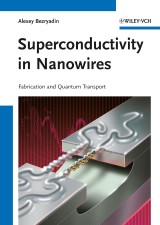Details

Superconductivity in Nanowires
Fabrication and Quantum Transport1. Aufl.
|
106,99 € |
|
| Verlag: | Wiley-VCH |
| Format: | |
| Veröffentl.: | 20.08.2012 |
| ISBN/EAN: | 9783527651962 |
| Sprache: | englisch |
| Anzahl Seiten: | 282 |
DRM-geschütztes eBook, Sie benötigen z.B. Adobe Digital Editions und eine Adobe ID zum Lesen.
Beschreibungen
The importance and actuality of nanotechnology is unabated and will be for years to come. A main challenge is to understand the various properties of certain nanostructures, and how to generate structures with specific properties for use in actual applications in Electrical Engineering and Medicine.<br> <br> One of the most important structures are nanowires, in particular superconducting ones. They are highly promising for future electronics, transporting current without resistance and at scales of a few nanometers. To fabricate wires to certain defined standards however, is a major challenge, and so is the investigation and understanding of these properties in the first place. A promising approach is to use carbon nanotubes as well as DNA structures as templates.<br> <br> Many fundamental theoretical questions are still unanswered, e.g. related to the role of quantum fluctuations. This work is tackling them and provides a detailed analysis of the transport properties of such ultrathin wires. It presents an account of theoretical models, charge transport experiments, and also conveys the latest experimental findings regarding fabrication, measurements, and theoretical analysis. In particular, it is the only available resource for the approach of using DNA and carbon nanotubes for nanowire fabrication.<br> <br> It is intended for graduate students and young researchers interested in nanoscale superconductivity. The readers are assumed to have knowledge of the basics of quantum mechanics and superconductivity.<br>
1 Introduction<br> 2 Selected Theoretical Topics Relevant to Superconducting Nanowires<br> 3 StewartMcCumber Model<br> 4 Fabrication of Nanowires Using Molecular Templates<br> 5 Experimental Methods<br> 6 Resistance of Nanowires Made of Superconducting Materials<br> 7 Golubev and Zaikin Theory of Thermally Activated Phase Slips<br> 8 Stochastic Premature Switching and Kurkij?arvi Theory<br> 9 Macroscopic Quantum Tunneling in Thin Wires<br> 10 SuperconductorInsulator Transition (SIT) in Thin and ShortWires<br> 11 Bardeen Formula for the Temperature Dependence of the Critical Current<br> Appendices<br> A Superconductivity in MoGe Alloys<br> B Variance and the Variance Estimator<br>
<b>Alexey Bezryadin</b> is Professor with the Micro- and Nanotechnology Laboratory and the Biophotonics Group at the University of Illinois at Urbana-Champaign. Previous assignments have taken him to CNRS Low-Temperature Research Center (CRTBT), France, the University of Delft, NL, and Harvard University. His research interests encompass techniques to enable novel investigations of systems with dimensions approaching 5 nm, fabrication of nanowires, loops, and SQUIDs by using carbon nanotubes as substrates, and also DNA templates.
<p><b>T</b>he importance and actuality of nanotechnology is unabated and will be for years to come. A main challenge is to apply Heisenberg’s Quantum Mechanics to understanding and design nanostructures with specific properties for use in actual applications in Electrical Engineering, Computer Technology, and Medicine.</p> <p>One of the most basic and also important structures are nanowires, in particular superconducting ones. They are highly promising for future electronics, transporting current without resistance and at scales of a few nanometers. To fabricate wires to certain defined standards however, is a major challenge, and so is the investigation and understanding of these properties in the first place. A promising approach is to use carbon nanotubes as well as DNA structures as templates.</p> <p>Many fundamental theoretical questions are still unanswered, e.g. related to the role of quantum fluctuations. This work is tackling them and provides a detailed analysis of the transport properties of such ultra-thin wires. It presents an account of theoretical models, charge transport experiments, and also conveys the latest experimental findings regarding fabrication, measurements, and statistical analysis of the fluctuations in ultrathin wires. In particular, it is the only available resource for the approach of using DNA and carbon nanotubes for nanowire fabrication.</p> <p><b>From the contents:</b></p> <ul> <li>Selected Theoretical Topics Relevant to Superconducting Nanowires</li> <li>Stewart-McCumber Model</li> <li>Fabrication of Nanowires Using Molecular Templates</li> <li>Experimental Methods</li> <li>Resistance of Nanowires Made of Superconducting Materials</li> <li>Golubev and Zaikin Theory of Thermally Activated Phase Slips</li> <li>Stochastic Premature Switching and Kurkijärvi Theory</li> <li>Macroscopic Quantum Tunneling in Thin Wires</li> <li>Superconductor-Insulator Transition (SIT) in Thin and Short Wires</li> <li>Bardeen Formula for the Temperature Dependence of the Critical Current</li> </ul>

















